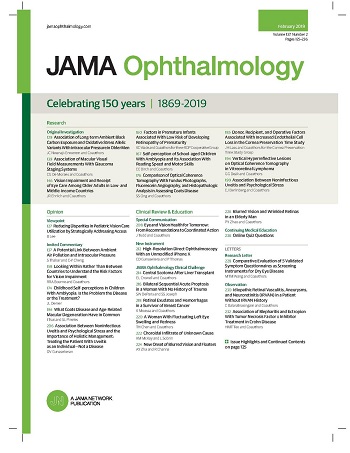Atropine or Cyclopentolate to Diagnose Premyopia in Preschool Children.
IF 9.2
1区 医学
Q1 OPHTHALMOLOGY
引用次数: 0
Abstract
Importance Sufficient cycloplegia is essential for reliable refraction in preschool children. The choice of cycloplegic agent may affect refraction and diagnosis outcomes. Objective To evaluate the objective refraction outcomes after cycloplegia in preschool children given either atropine or cyclopentolate. Design, Setting, and Participants This was a post hoc analysis of the 2024 Preschool Children Refractive Development Pattern and Influencing Factors Study (PRDP-IFS), in which children were given atropine, and the 2013 to 2014 Elaborative Shanghai Childhood Ocular Refractive Development Study (E-SCORDS), in which children were given cyclopentolate. These were population-based studies. Eyes in each group were included via propensity score matching. Study data were analyzed from December 2024 to July 2025. Exposures Cycloplegia induced by either 1% atropine (twice daily for 4 days with an additional dose on day 5) or 1% cyclopentolate (dual administration 5 minutes apart) eye drops. Main Outcomes and Measures Difference between the noncycloplegic and cycloplegic spherical equivalent (DSE) and the prevalence of refractive states were compared in the atropine and cyclopentolate groups. Refractive states (moderate to high hyperopia, low hyperopia, premyopia, and myopia) were determined by cycloplegic spherical equivalent (SE) using an autorefractor. Results A total of 1761 children and their 3048 eyes were included in this study. There were 773 children (1524 eyes) in the atropine group (mean [SD] age, 4.62 [0.92] years; 406 male [52.5%]) and 988 children (1524 eyes) in the cyclopentolate group (mean [SD] age, 4.62 [0.93] years; 530 male [53.6%]). There were a total of 1524 eyes in each group. The mean (SD) noncycloplegic SE was 0.30 (0.92) diopters (D) and 0.31 (0.76) D in the atropine and cyclopentolate groups, respectively (mean difference, -0.01 D; 95% CI, -0.07 to 0.05 D; P = .72). Mean (SD) DSE in the atropine group was 1.56 (0.72) D and in the cyclopentolate group was 0.97 (0.70) D. The mean difference in DSE between the 2 groups was 0.59 D (95% CI, 0.54-0.64 D; P < .001). The difference in the percentages of refractive states between the atropine and cycloplegic groups was as follows: moderate to high hyperopia (7.2% vs 2.7% = 4.5%; 95% CI, 2.9%-6.0%; P < .001), low hyperopia (82.8% vs 74.0% = 8.8%; 95% CI, 6.0%-11.8%; P < .001), premyopia (8.7% vs 21.6% = -12.9%; 95% CI, -15.4% to -10.4%; P < .001), and myopia (1.3% vs 1.8% = -0.5%; 95% CI, -1.3% to 0.4%; P = .30). Conclusions and Relevance This study found that use of atropine for cycloplegia in preschool children was associated with less myopic refraction compared with cyclopentolate and may potentially avoid overestimation of premyopia prevalence; however, this investigation did not evaluate each cycloplegic agent in the same children.阿托品与环戊酸酯诊断学龄前儿童近视眼。
充分的睫状体麻痹对于学龄前儿童可靠的屈光是必不可少的。麻痹剂的选择可能影响屈光和诊断结果。目的评价学龄前儿童睫状体麻痹后给予阿托品或环戊酸酯治疗的客观屈光效果。设计、环境和参与者:本研究是对2024年学龄前儿童屈光发育模式及影响因素研究(PRDP-IFS)和2013 - 2014年上海儿童屈光发育研究(E-SCORDS)的事后分析,前者给予儿童阿托品,后者给予儿童环戊酸酯。这些是基于人群的研究。通过倾向评分匹配纳入各组的眼睛。研究数据分析时间为2024年12月至2025年7月。暴露于1%阿托品(每天两次,连续4天,第5天额外剂量)或1%环戊酸酯(两次给药,间隔5分钟)滴眼液引起的cyclople瘫。比较阿托品组和环戊酸酯组非睫状体瘫痪和睫状体瘫痪的球形当量(DSE)和屈光状态发生率的差异。屈光状态(中度至高度远视、轻度远视、准近视眼和近视)采用自折射仪测定。结果共纳入儿童1761例,共3048只眼。阿托品组患儿773例(1524眼)(平均[SD]年龄4.62[0.92]岁,男性406例(52.5%)),环戊酸酯组患儿988例(1524眼)(平均[SD]年龄4.62[0.93]岁,男性530例(53.6%))。每组共1524只眼。阿托品组和环戊酸酯组非环瘫SE的平均(SD)分别为0.30(0.92)和0.31 (0.76)D(平均差异为-0.01 D; 95% CI为-0.07 ~ 0.05 D; P = 0.72)。阿托品组的平均(SD) DSE为1.56 (0.72)D,环戊酸酯组的平均(SD) DSE为0.97 (0.70)D,两组间的平均差异为0.59 D (95% CI, 0.54 ~ 0.64 D; P < 0.001)。阿托品组和单眼麻痹组屈光状态百分比的差异如下:中度至高度远视(7.2% vs 2.7% = 4.5%; 95% CI, 2.9% ~ 6.0%; P <。001),低远视(82.8% vs 74.0% = 8.8%; 95%置信区间,6.0% -11.8%;P <。001), premyopia (8.7% vs 21.6% = -12.9%; 95%置信区间,-15.4%到-10.4%;P <。001),和近视(1.3% vs 1.8% = -0.5%; 95%置信区间,-1.3%到0.4%;P = .30)。本研究发现,与环戊酸酯相比,使用阿托品治疗学龄前儿童单眼麻痹可减少近视屈光度,并可能避免高估近视眼患病率;然而,这项调查并没有对同一儿童的每种致瘫药物进行评估。
本文章由计算机程序翻译,如有差异,请以英文原文为准。
求助全文
约1分钟内获得全文
求助全文
来源期刊

JAMA ophthalmology
OPHTHALMOLOGY-
CiteScore
13.20
自引率
3.70%
发文量
340
期刊介绍:
JAMA Ophthalmology, with a rich history of continuous publication since 1869, stands as a distinguished international, peer-reviewed journal dedicated to ophthalmology and visual science. In 2019, the journal proudly commemorated 150 years of uninterrupted service to the field. As a member of the esteemed JAMA Network, a consortium renowned for its peer-reviewed general medical and specialty publications, JAMA Ophthalmology upholds the highest standards of excellence in disseminating cutting-edge research and insights. Join us in celebrating our legacy and advancing the frontiers of ophthalmology and visual science.
 求助内容:
求助内容: 应助结果提醒方式:
应助结果提醒方式:


